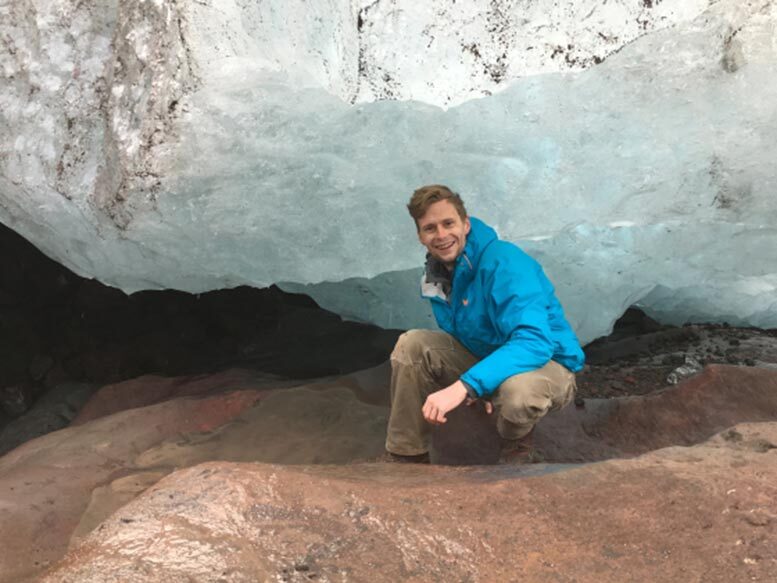Doctoral candidate Eric Dunham of MSU's Department of Microbiology and Immunology in the College of Agriculture, along with mentor Eric Boyd, published their findings in the journal Proceedings of the National Academy of Sciences in December 2020. The work examines the ways water and microbes interact with the bedrock beneath glaciers, using samples of sediment taken from glacial sites in Canada and Iceland.
"We kept finding organisms in these systems that were supported by hydrogen gas," said Boyd of the inspiration for the project. "It initially didn't make sense, because we couldn't figure out where that hydrogen gas was coming from under these glaciers."
A team of researchers, including Boyd, later discovered that through a series of physical and chemical processes, hydrogen gas is produced as the silica-rich bedrock underneath glaciers is ground into tiny mineral particles by the weight of the ice on top of it. When those mineral particles combine with glacial meltwater, they let off hydrogen.
What became even more fascinating to Boyd and Dunham was that microbial communities under the glaciers could combine that hydrogen gas with carbon dioxide to generate more organic matter, called biomass, through a process called chemosynthesis. Chemosynthesis is similar to how plants generate biomass from carbon dioxide through photosynthesis, although chemosynthesis does not require sunlight.
To learn more about what those chemosynthetic microbes were doing, Dunham used samples of sediment from the glaciers in Canada and Iceland. He grew samples of the living organisms found in the sediment in a laboratory, watching them over several months to see if they would continue to grow in the simulated environment.
"The organisms we were interested in rely on hydrogen gas as food to grow, and most are also anaerobes, meaning oxygen will kill them," said Dunham, who is originally from Billings and is entering the final semester of his doctoral studies. "One of the most critical steps in preparing these experiments, and easily the most stressful element, was getting those samples into bottles and flushing out all the oxygen as quickly as possible, so I didn't kill the organisms I was trying to study."
Over months of preparing and observing the microbial cultures, Dunham found that not only was it possible to track the communities' growth in the lab environment but also that the type of bedrock underlying a glacier influenced how much hydrogen gas was produced, which in turn led to the presence of microbial communities that were better adapted to metabolizing hydrogen. Samples taken from the Kötlujökull Glacier in Iceland, which sits atop basaltic bedrock, produced much more hydrogen gas than the samples from Robertson Glacier in Alberta, Canada, which has carbonate bedrock beneath it.
As they use that hydrogen gas to generate energy, said Boyd, the microbes also pull carbon dioxide out of the air to create biomass, replicate and grow. That ability to "fix" carbon is a critical climate regulation process, another similarity to photosynthesis in plants.
"Considering that glaciers and ice sheets cover about 10% of the Earth's landmass today, and a much larger fraction at times in the planet's past, microbial activities such as the ones Eric measured are likely to have had a major impact on Earth's climate, both today and in the past," said Boyd. "We've known for a while that microorganisms living beneath ice sheets or glaciers can fix carbon, but we never really understood how. What Eric's pioneering work shows is that not only are these organisms completely self-sustainable in the sense that they can generate their own fixed carbon, they also don't need sunlight to do it like the rest of the biosphere that we're familiar with."
Looking further afield at the other planets in our solar system, Boyd notes that two of the critical elements scientists look for when evaluating habitability are water and a source of energy. The newfound knowledge that self-sustaining microbial communities can flourish in icy environments through the generation of hydrogen gas is a critical step toward identifying potentially habitable environments on other planets.
"There's lots of evidence for ice and glaciers on other planets," he said. "Are they habitable? We don't know. Could there be microbes living under ice sheets on planets with bedrock similar to those that Eric studied? Absolutely. There's no reason to think otherwise."
For Dunham, whose undergraduate and postbaccalaureate research focused on health sciences and virology before shifting to biogeochemistry, the most rewarding part of the new discovery is exploring how various Earth processes fit together and influence one another in ways that the scientific community is only beginning to unlock.
Reference: "Lithogenic hydrogen supports microbial primary production in subglacial and proglacial environments" by Eric C. Dunham, John E. Dore, Mark L. Skidmore, Eric E. Roden and Eric S. Boyd, 21 December 2020, Proceedings of the National Academy of Sciences.
DOI: 10.1073/pnas.2007051117




Comment: It appears that there are few areas on our planet that aren't teaming with life:
- Microorganisms in parched regions extract needed water from colonized rocks
- 'Electric mud' teems with new, mysterious bacteria that may rewrite textbooks
- Dead Zone? Area with no life found on Earth
- Fungi that absorbs radiation has been growing all over Chernobyl plant
And check out SOTT radio's: The Truth Perspective: Are Cells the Intelligent Designers? Why Creationists and Darwinists Are Both Wrong